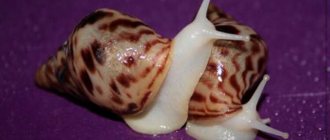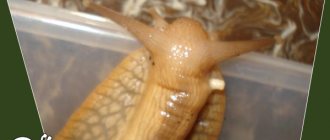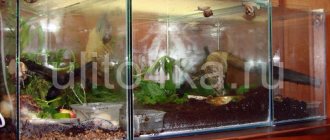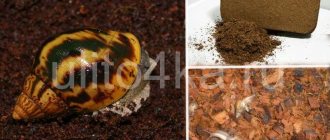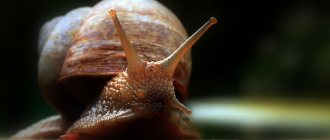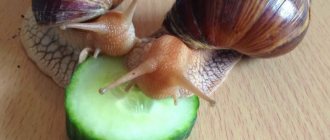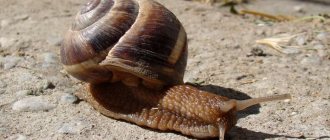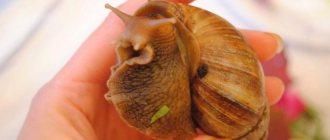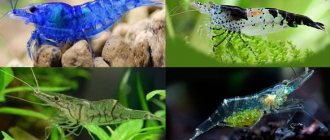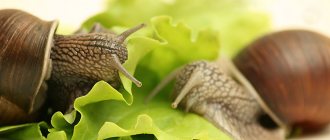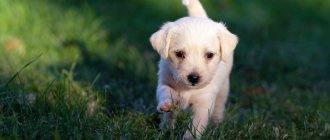Is it possible to give tomatoes to Achatina snails?
Tomatoes are universal vegetables for Achatina. They can be given in cut pieces, in the form of a tomato cocktail with calcium or gammarus. Available in fresh, dried and frozen form. Tomatoes are rich in healthy carbohydrates, fiber, vitamins and microelements.
Interesting materials:
How many points for each OGE computer science assignment? How much gasoline can I leave in Delimobil? How much do appraisers charge? How many free channels are there in Moscow? How many tickets can you write down for three? How many twins can there be? How many cartons of cigarettes can you import into Turkey? How many blocks are there in 1 sq m? How many barrels fit in a 40ft container? How many broilers can be placed per m2?
What do Achatina eat in nature?
In nature, snails independently determine the norm, as well as what they can eat and what they cannot.
In captivity, Achatina's main food is vegetation. They also eat mushrooms, algae, moss, lichens, bark and tree fruits.
Young snails prefer live plants and fresh fruits. Adults can feed on rotting plants and carrion.
To build and strengthen their shells, snails eat particles of limestone and shells of dead mollusks.
Effect of calcium on shellfish
Snails need calcium to build their shells. Calcium is a very common chemical element.
Lack of calcium in the snail's diet leads to curvature and deformation of the shell. The snail shell becomes softer due to lack of calcium; it is not protected from the environment. Since all internal organs are attached to the walls of the shell, any damage to it can lead to improper functioning of the organs or death. A mollusk that does not receive calcium from food, as a rule, lags behind in development: shell growth is disrupted or stops altogether, and puberty fails.
In order to prove how important calcium is for snails, I conducted an experiment.
Two groups of snails of the same age and species were taken and placed in the same conditions, but they were fed differently: some with food with added calcium, others with its complete absence.
Soon the snails of the second group stopped growing. It follows from this that calcium is indispensable for mollusks.
What is contraindicated for Achatina
Salt is strictly contraindicated for snail
One of the basic rules of care is knowledge: snails do not eat what people eat and prepare for themselves. Especially it concerns:
- Salty food.
Salt, even in the smallest amount, is detrimental to Achatina. The owner should get into the habit of reading the ingredients of any purchased food and under no circumstances give snails food that contains salt.
- Flour products.
It is no less deadly and harmful, for example, pasta.
- Newspapers.
One of the amazing habits is that snails eat newspapers, and whenever possible they are not averse to eating them. This should not be allowed, as printing ink can lead to the death of an illegible pet.
Eating sweets, citrus fruits, fried, smoked, pickled, spicy, and sour foods is contraindicated for shellfish. It is not recommended to give large pieces of any product with loose pulp, as the snail can burrow into it and suffocate.
Zucchini and eggplant
While giving zucchini to snails is not only possible, but also necessary, the situation with eggplants is different. Let's consider this topic in more detail.
Shellfish do not develop food dependence on zucchini, even if they are regularly present in the diet. They are rich in vitamins, beneficial microelements, and cannot harm snails.
For all its advantages, this product is very low in calories. Therefore, it must be included in the clam feeder along with grain mixtures and nutritional supplements.
This vegetable tolerates freezing well, so it is harvested seasonally.
Eggplant, unlike zucchini, is considered a product harmful to snails. Its composition (especially in the peel) contains a lot of solanine, which in a certain concentration is dangerous even for humans, not to mention snails. It is advisable to completely exclude this product from your pets’ diet.
Calcium in the diet
In order for a snail's shell to be strong and beautiful, it needs calcium. It should be in your daily diet . This is a mandatory condition for keeping a snail in a terrarium. There are several options for calcium supplements:
- Cuttlefish, or rather, its shell. The most popular option. Looks like a white oval object. All you have to do is put it near the snails and watch them eat it.
- Feed chalk is an inexpensive feed in powder form. You can sprinkle it on fruits and vegetables.
- Eggshells ground into flour.
- Seashells.
In no case. Do not add human calcium supplements to your diet. This will only harm the snail. You should not give school chalk and mineral stones to parrots, as their composition is dangerous to the health of Achatina.
What to feed at home
At home, the diet of Achatina snails depends entirely on the owner.
The snail's diet consists of:
- Greenery;
- Vegetables, fruits and berries;
- Protein food;
- Water;
- Cereals and cereals;
- Mineral feeding.
It is important to diversify the snail's diet, since Achatina quickly gets used to one food and may subsequently refuse something new.
Greenery
The basis of the snails diet is greens. This also includes shoots of young trees, vegetable tops, and shoots of cereal crops.
From greens, snails eat:
- Dandelion;
- Nettle;
- Plantain;
- Clover;
- Burdock;
- Chamomile.
In the summer in the garden you can collect and feed:
- Dill;
- Parsley;
- Lettuce leaves;
- Spinach;
- Beet tops;
- Carrot tops.
Before feeding the grass to the snails, it must be thoroughly washed. Green grass should be collected away from the road, in an ecologically clean area. Large leaves are torn into small pieces.
You can also offer the snails leaves of trees and shrubs:
- Birches;
- Linden trees;
- Oak;
- Apple trees;
- Raspberries.
Vegetables, fruits and berries
Fruits, berries and vegetables are given fresh in the summer. Vegetables and fruits must be thoroughly washed before serving. For adult snails, cut into small pieces, and for young snails, you can grate them.
Vegetables you can give Achatina:
- Cucumbers;
- Tomatoes;
- Carrot;
- Cabbage;
- Broccoli;
- Zucchini;
- Pumpkin;
- Corn;
- Peas.
Fruits and berries:
- Apples;
- Pears;
- Peaches;
- Apricots;
- Banana;
- Watermelon;
- Melon;
- Avocado;
- A pineapple;
- Strawberries;
- Cherry;
- Raspberries;
- Grape;
- Plum.
In winter, you can buy vegetables and fruits in the store. But it is worth considering that they can be treated with chemicals. Therefore, snails are often offered frozen food in winter. Before feeding frozen vegetables, they must be thawed. All food offered to snails should be at room temperature.
Keeping the Achatina snail (Terrarium)
A terrarium for Achatina can be made from a simple aquarium. The minimum size is 10 liters per snail. The larger the aquarium, the larger your snail will grow. The terrarium must have a lid, because snails can crawl out of it. It is advisable to arrange small holes in the lid for better gas exchange. As a last resort, you can simply lift the lid to create a small gap. You need to put bedding on the bottom of the aquarium. The bedding can be Begonia soil, or ideally a coconut substrate 5-7 cm thick. You can build a small bath with fresh water; Achatina loves to swim. The main thing is that the depth of the bath does not allow the snail to choke. In general, Achatina crawl well under water, but if it accidentally falls into the bath from above, a small snail can drown from fright. You also need to make sure that the bath does not turn over if the snail starts to burrow into the soil next to it, otherwise the water will spread out, which is not good.
The temperature and humidity required by Achatina are approximately the same as those in an ordinary city apartment. Soil moisture is determined empirically. If the snails sit on the walls of the terrarium all the time, it means there is too much water. If they prefer to be sealed (the evidence is hidden in the sink and closed with a lid), on the contrary, it is too dry. When the soil moisture is normal, snails crawl along its surface at night and often burrow into it during the day. To maintain humidity, it is enough to spray the soil and walls of the terrarium with a spray bottle twice a day.
To awaken a clogged snail, you can pour water over its mouth and carefully remove the cap, or simply place it in a terrarium with normal humidity. It is recommended to wash the terrarium at least once a week. The exception is a terrarium with a clutch of eggs, which must be cleaned without water so as not to change the humidity and not damage the clutch.
It is better to keep small snails without soil, covering them with cabbage or lettuce leaves, thereby increasing the chance of the snail finding food and making it easier to care for the terrarium.
What foods are prohibited for snails?
6 It is strictly forbidden to feed the snail spicy, sweet, smoked and pickled foods.
SALT is certain death for a snail
7 Oranges and lemons contain acid, which, with prolonged contact, injures the delicate body of the snail and destroys its shell. Therefore, it is better to refuse them or give them very rarely and in small portions.
8 Be careful with nightshade vegetables. Do not feed Achatina with unripe tomatoes or “green” potatoes. Boil potatoes and eggplant before giving them to the snail. 9 White flour and flour products (especially PASTA) are contraindicated for shellfish. Their digestive system cannot digest them, which leads to intestinal obstruction and death of the animal.
When to give food
Achatina snails are nocturnal mollusks. During the day they sleep, buried in the ground, and in the evenings they become active and quickly crawl around their home, hoping to find something edible. That is why it is advisable to feed snails in the evening or at night.
It is better to feed the snail in the evening; be sure to place the food on a plate.
It is better to let the snails eat on a plastic tray with low edges or on a saucer, which can be easily removed after dinner, which allows you to maintain the cleanliness of the molluscarium (aquarium). It is undesirable to place food on the ground, as this leads to contamination and rapid spoilage. Achatina does not eat all the food at once, trying to prolong the pleasure. But with sufficiently high humidity, necessary for the normal functioning of shellfish, the food quickly begins to rot and become moldy, so after some time it is better to remove the remaining products.
Vegetables
In addition to fruits, you can feed your pet fresh vegetables. Fortunately, they are inexpensive and available all year round. You can give tomatoes , zucchini, cabbage, pumpkin, sweet potatoes, sweet peppers and much more. The technology is the same as with fruits - the vegetable is cut into slices or small pieces and placed in a terrarium. The snail owner can watch his pet crawl onto the product and bite off small pieces of the vegetable.
Try not to buy greenhouse vegetables. Due to the addition of fertilizer during cultivation, they can have a bad effect on the snail. Eggplant, potatoes, turnips, olives and black olives can be given with caution. Under no circumstances should you give onions, garlic or any spicy vegetables!
What else can you feed snails?
The daily diet should be varied. If you feed Achatina with the same food for a long time, they will get used to it and refuse other food.
To strengthen the shell, snails need to be given cereals and cereals:
- Hercules;
- Oatmeal;
- Millet cereals;
- Buckwheat;
- Hercules;
- Corn;
- Barley;
- Barley;
- Lentils;
- Rice;
- Sunflower seeds;
- Flax seeds;
- Sesame;
- Cereals.
It will also be useful for snails to feed cottage cheese, oat bran, mushrooms, dry cookies, and meat.
The most important stage in feeding Achatina snails is mineral feeding. If there is a lack of minerals, the snail will get sick and growth will stop. You can also observe deformation of the shell, delamination, damage, and cracks will appear.
To form a strong and healthy shell, snails must be fed:
- Eggshells;
- Shell rock;
- Feed chalk;
- Limestone;
- Sepia;
- Gammarus;
- Daphnia;
- Cuttlefish shell.
Fruits
Thanks to year-round access to fruit , the kipper has no problems with what to feed the snails. At any time you can find bananas, kiwi, mangoes and other fruits on store shelves. Apples, pears, melons and others are no less useful for snails. But there are some caveats here. The Achatina snail is sensitive to certain types of fruits. So, persimmons, cherries, feijoas, oranges and tangerines can only be given with caution and only after checking for ripeness. The fruit should be sweet, not viscous, not sour. For the last reason, you should not give any sour berries (lingonberries, cranberries, etc.) and sour fruits (lemon, pineapple, pomegranate, etc.).
Large fruits are cut into slices or small pieces and placed in a terrarium. In order not to stain the soil, they can be placed in a bowl (you can buy it at a pet store).
Allowed berries
You should not heavily feed your snail with berries all summer. Berries in general are more acidic than fruits.
Most of the berries grow in the summer. Berries for the most part contain a lot of acids, but some of them can be given to your pet in limited quantities:
- watermelon;
- cherries;
- grape;
- raspberries;
- strawberry;
- blueberries, blueberries (within reason, as they contain a lot of pectin);
- strawberries
Watermelon can be given in sufficient quantities. You just need to buy it during the season and not on the roadsides.
Cherries are also not forbidden. My snail happily eats half or even a whole berry a day during the summer season.
The snail receives all the other berries listed above in limited quantities and only if they are sweet and not fermented. Strawberries are known to contain a lot of acid, but some varieties are very sweet. These end up “on the table” of Chamomile and are eaten with pleasure by her. By the way, blueberries are also my snail’s favorites.
How to eat snails correctly?
The snail is eaten whole. Like an oyster, it is not cut. Before putting the snail in your mouth, you can carefully drink the oil from its shell (escargot is often prepared with garlic butter) or pour it over a piece of baguette. Next are recipes for dishes that can be prepared from grape snails.
Interesting materials:
Is it possible to have fold-eared cats? Is it possible to mix dry cat food from the same manufacturer? Can you mix dry and wet cat food? Is it possible to combine dry and natural cat food? Is it possible to sleep with a cat? Is it possible to sterilize a cat after she has given birth? Is it possible to sterilize a cat at home? Is it possible to sterilize an older cat? Is it possible to trim a cat's eyebrows? Is it possible to trim the nails of British kittens?
Why does a snail need calcium?
10 To build a strong and beautiful shell, the African snail needs calcium. The main sources of calcium are: ground eggshells, feed chalk, cuttlefish shell. You need to be careful with cuttlefish shells, as they may contain large amounts of salt. Therefore, soak the shell in water for several hours. Edible chalk can now be bought at a pet store, but it has nothing in common with the multi-colored drawing crayons that are sold in office supplies; colored crayons should not be given to Achatina.
Eggshells are an ideal source of calcium.
Raw shells are softer and are better absorbed by the snail than boiled shells. Washed and dried raw shells can be ground in a coffee grinder (about 7 seconds), crushed in a mortar, or simply rolled several times with a rolling pin.
How to prepare calcium mixture
- Buckwheat – 100 gr.
- Oatmeal (Hercules) - 100 gr.
- White rice - 80 gr.
- Wheat cereal - 80 gr.
- Eggshells - 4 pcs.
- Edible chalk - 30 gr.
- Soaked and dried cuttlefish shell or sepia.
Grind all the ingredients one by one in a coffee grinder or blender, then mix everything and place in a dry, airtight container. The yield of the calcium mixture is about 800 g. Read recipes for healthy feeding for the proper growth and development of snails here .
Well-designed diet
Domestic snails are notable for their size. For proper development they need a spacious container. It is believed that a volume of 15 liters is sufficient for one individual. With smaller volumes, the snail is unlikely to become large. The condition for longevity and well-being of a pet is proper feeding. To do this you need to follow a few simple rules:
- Food is given at night as it is a nocturnal animal.
- Uneaten leftovers must be removed immediately - otherwise the midges will not keep you waiting.
- Any products must be fresh - rotten and low-quality vegetables or fruits can harm the snail.
- Calcium should be freely available to the snail.
- Some products are controversial as to their harmlessness to Achatina and should be given with caution.
Over time, you may notice that some snails have preferences for certain foods and have eating habits. For this reason, it is not recommended to use the same ingredients. The diet should be varied.
Parrots
At the beginning of the article, mention was made of tannins that are part of persimmon. It is worth noting that they are mandatory elements of food for birds, and especially for parrots, including budgies. For them, persimmon is a valuable source of tannins, vitamins, minerals and other beneficial substances.
In addition, this fruit, as you know, is a seasonal product, and including it in the diet of parrots helps to maintain seasonal feeding, which, in turn, has a positive effect on the bird’s immune system.
